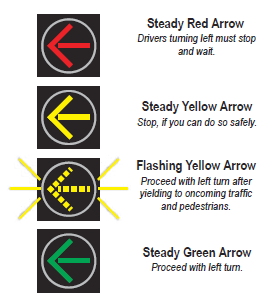The ability for motorists to successful make left turns is critical to the safety and efficiency of signalized intersections.
In order to improve operation of traffic signals, the Federal Highway Administration (FHWA) has adopted the flashing yellow left-turn arrow as a national standard. A comprehensive National Cooperative Highway Research Program (NCHRP) study demonstrated that flashing yellow left-turn arrows are superior to traditional yield-on-green indications in terms of driver understanding and compliance, reducing severe crashes by 25 percent, while at the same time delivering greater operational efficiency (less delay). The flashing yellow arrow communicates to motorists that they must proceed with care and decide if there is a sufficient gap in oncoming traffic to safely make a left turn.
A flashing yellow arrow signal indicates a permissive phase where left turners may make their turn if there are no opposing through vehicles. The flashing yellow arrow may be displayed before and/or after the protected green and solid yellow left turn arrows to improve traffic flow. The steady yellow arrow retains its standard meaning: The left-turn signal is about to change to a steady red arrow and drivers should prepare to stop or, if they have already entered the intersection, they should complete the left turn when oncoming traffic has cleared.
The flashing yellow left-turn arrow improves intersection safety by providing clearer instruction to left-hand turning drivers during the entire signal phase. Their use in the same signal head with a solid green arrow provides traffic engineers with more options to handle variable traffic volumes — during higher traffic volume periods of the day the solid green arrow for protected left turns can still be used if appropriate for traffic and site conditions, but when traffic volumes decrease the flashing yellow arrow (permissive) can be displayed to reduce the delay motorists experience in making left turns.
In other ways, a flashing yellow arrow signal offers benefits over traditional five-section traffic signals, also known as a “doghouse” given its shape. Among them is that a five-section signal’s left-turn phase cannot operate as protected only with the green and solid yellow arrows part of the time, and then as protected/permissive during other times of the day, depending on traffic flows.
INDOT will continue over the next decade and beyond the process that began in 2013 of statewide modernization to the new four-section flashing yellow left-turn traffic signal heads, where traffic and site conditions are suitable for protected/permissive operation. That incremental process targets new traffic signals and upgrades to existing locations where the current traffic signals’ service life has been reached.
Related Links
Contact Information
Transportation Services Call Center
Indiana Department of Transportation
100 N. Senate Ave., IGCN 755
Indianapolis, IN 46204
855-463-6848
indot4u.com

